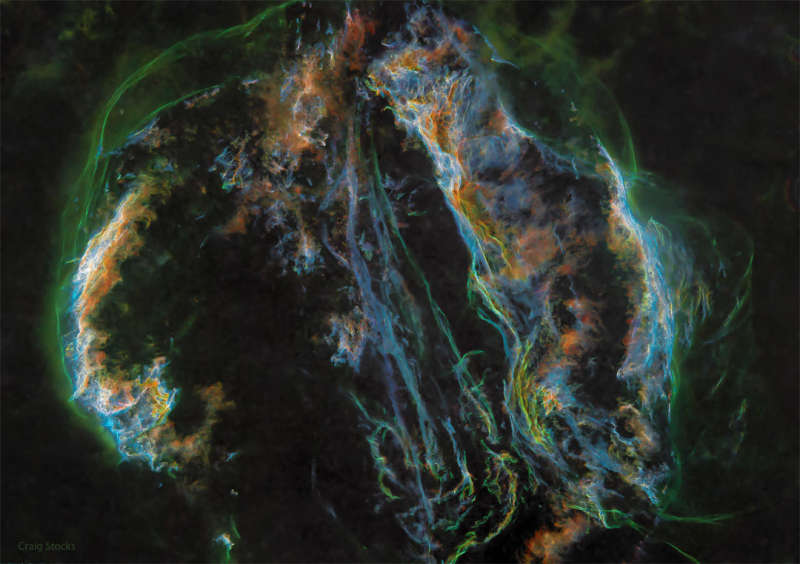
|
Credit & Copyright: Craig Stocks
(Utah Desert Remote Observatories)
Explanation:
Ten thousand years ago, before the dawn of
recorded human history,
a new light would have suddenly have appeared in the
night sky and faded after a few weeks.
Today we know this light was from a
supernova,
or exploding star,
and record the expanding debris cloud as the
Veil Nebula, a
supernova remnant.
Imaged with color filters featuring light emitted by
sulfur (red),
hydrogen (green), and
oxygen (blue),
this deep wide-angle view was processed to remove the
stars
and so
better capture the impressive glowing filaments of the Veil.
Also known as the
Cygnus Loop, the
Veil Nebula
is roughly circular in shape and covers nearly
3 degrees on the sky toward the
constellation of the Swan (Cygnus).
Famous nebular sections include the
Bat Nebula, the
Witch's Broom Nebula, and
Fleming's Triangular Wisp.
The complete supernova remnant lies about 1,400
light-years away.
|
January February March April May June July August September October November December |
| ||||||||||||||||||||||||||||||||||||||||||||||||
NASA Web Site Statements, Warnings, and Disclaimers
NASA Official: Jay Norris. Specific rights apply.
A service of: LHEA at NASA / GSFC
& Michigan Tech. U.
Based on Astronomy Picture
Of the Day
Publications with keywords: Veil Nebula - supernova remnant
Publications with words: Veil Nebula - supernova remnant
See also:
- APOD: 2025 October 1 Á NGC 6960: The Witchs Broom Nebula
- APOD: 2025 June 9 Á Between Scylla and Charybdis: A Double Cosmic Discovery
- APOD: 2025 June 2 Á Veil Nebula: Wisps of an Ancient Supernova
- Supernova Remnant Cassiopeia A
- APOD: 2025 January 8 Á Supernova Remnants Big and Small
- APOD: 2024 September 18 Á The Mermaid Nebula Supernova Remnant
- APOD: 2024 September 4 Á NGC 6995: The Bat Nebula
